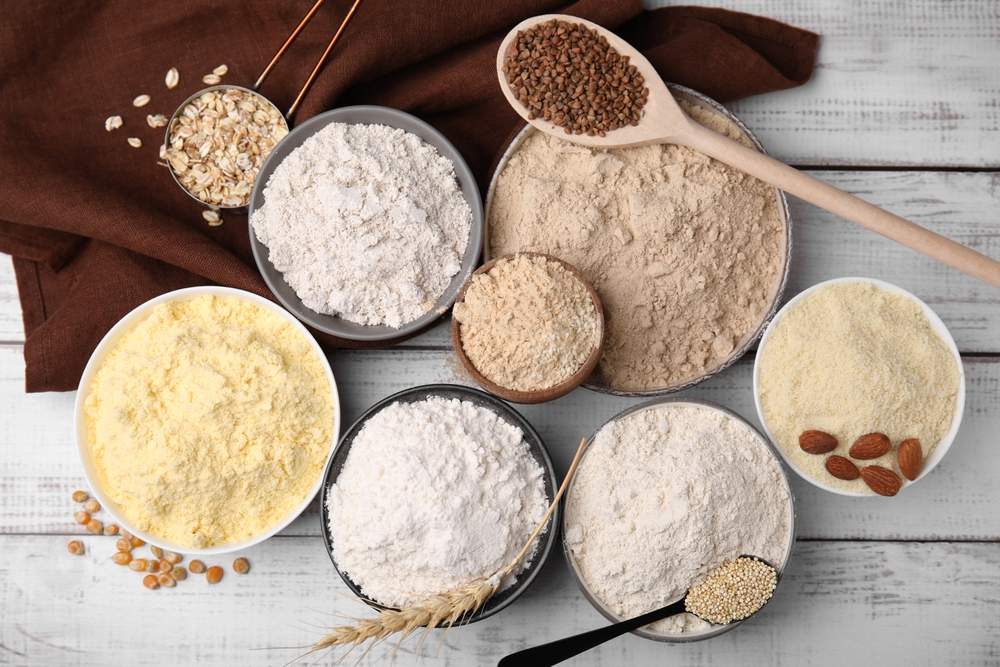5 types of flour you can use in the kitchen

Discover 5 healthy and nutritious types of flour, see the benefits of their consumption and how you can integrate them into your daily diet. Flour, a fundamental ingredient in the kitchen, is used all over the world in a wide range of recipes. However, not all types of flour are equal in terms of their nutritional value and health benefits. In the following lines, we present to you five types of flour, which contain not only complex carbohydrates, the so-called \. Almond flour\n. It also contains important minerals such as magnesium, calcium and iron and is an excellent source of monounsaturated fats, which can help maintain heart health.
Almond flour is considered a healthier option than regular wheat flour as it is high in protein and fibre, which can help keep you full, and it is gluten free. It is a versatile ingredient in the kitchen, successfully replacing white wheat flour and can be used in a variety of recipes such as: cakes, American fluffy pancakes, gluten-free biscuits and cakes, doughs, in smoothies, porridges or . Coconut flour\n. It also does not contain gluten, making it suitable for people with gluten intolerance. It can be used in many ways: in cakes, pancakes and other desserts to give them a subtle coconut flavor, as a substitute for some wheat flour in gluten-free recipes such as bread and biscuits, in savory dishes such as .
Since coconut flour has a higher calorie content than wheat flour, it is important to consume it in moderation, especially if you follow a low-calorie diet. Quinoa flour\n. It is an excellent source of protein, containing all nine essential amino acids, making it an ideal option for vegetarians and vegans. It is also rich in fibre, iron, magnesium, phosphorus, manganese and B vitamins such as B2 and B6. Quinoa flour can be used in a wide range of recipes.
It can be added to bread dough, pancake mix or cake mix to improve the nutritional value of dishes. It can also be used to bind sauces or to give consistency to soups and stews. Buckwheat flour\n. It is a good source of protein, fibre, B vitamins (especially B1 and B2) and minerals such as magnesium, phosphorus and iron. It is also rich in antioxidants such as rutin and quercetin, which may have health benefits.
Buckwheat flour is gluten-free, making it ideal for the diet of people suffering from gluten intolerance or celiac disease, as they can use buckwheat flour as a substitute for wheat flour. It is often used to prepare gluten-free bakery products, such as bread, gingerbread or doughs for vegetable tarts. It can also be used to thicken sauces or give consistency to soups. Chickpea flour\n. This makes it an excellent option for vegetarians and vegans, but also for those who want to reduce their meat consumption.
It is also rich in essential nutrients, being a good source of fiber, vitamins and minerals. It also contains slow-absorbing carbohydrates, which help keep blood sugar levels within normal limits and provide long-term energy. Chickpea flour can be used in a variety of culinary preparations: as a substitute for wheat flour in pasta, bread and cake recipes, a thickener for soups and sauces or as a raw material for pancakes and doughnuts. Regardless of the type of flour you choose, make sure you integrate it correctly into a balanced and healthy diet. Also, remember to always check the label and make sure you're choosing quality products without unnecessary additives or preservatives.
.
Source : kudika.ro
Views : 1240
Popular Article
- (photo) Nude becomes art.
Posted: 2018-03-17, 9866 views.
- The harmful effects of air conditioning on the skin
Posted: 2017-06-08, 8587 views.
- 3 causes of dyed hair discoloration
Posted: 2017-06-15, 8461 views.
- Why early puberty occurs in girls: symptoms, favors, diagnosis and treatment
Posted: 2017-10-24, 8303 views.
- Good or bad skin treatments in the hot season
Posted: 2017-06-07, 8031 views.
Recommendations
- (photo) Nude becomes art.
Posted: 2018-03-17, 9866 views.
- The harmful effects of air conditioning on the skin
Posted: 2017-06-08, 8587 views.
- 3 causes of dyed hair discoloration
Posted: 2017-06-15, 8461 views.
- Good or bad skin treatments in the hot season
Posted: 2017-06-07, 8031 views.
- Risks of practicing sports on hot days
Posted: 2017-06-12, 7608 views.
 4 effective ingredients in the fight against acne.
4 effective ingredients in the fight against acne. How to get rid of hiccups fast
How to get rid of hiccups fast The wheat bran diet: the secret of lost pounds as if by magic
The wheat bran diet: the secret of lost pounds as if by magic The recipe that will sweeten your soul this weekend!
The recipe that will sweeten your soul this weekend!  Is it dangerous or not to refreeze meat after thawing it?
Is it dangerous or not to refreeze meat after thawing it?  The unusual sign of diabetes indicated by saliva.
The unusual sign of diabetes indicated by saliva. What to drink to boost your immune system.
What to drink to boost your immune system. 10 foods that help you never age.
10 foods that help you never age. What actually happens in your body if you drink a cup of coffee for breakfast
What actually happens in your body if you drink a cup of coffee for breakfast 5 surprising benefits of chia seeds
5 surprising benefits of chia seeds